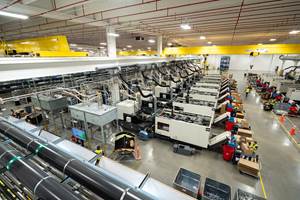First PVC Long-Fiber Composites Debut
SolVin has developed technology that allows production of what are said to be the world’s first PVC long- or continuous-fiber composites.
SolVin, the vinyls production unit of the Solvay Group in Brussels, Belgium, has developed technology that allows production of what are said to be the world’s first PVC long- or continuous-fiber composites. The company launched this innovation at the JEC Europe composites show in Paris in March as part of the firm’s sustainable development efforts.
In addition to its mainstay SolVin PVC resins, the company’s latest NanoVin eco-friendly, ready-to-use, aqueous, nanostructured PVC dispersions now can be formulated for long- or continuous-fiber impregnation. Explains Claudine Bloyaert, technical manager, “This breakthrough in formulation of concentrated latex of homopolymer PVC, combined with our advancement in nanotechnology, is the outcome of several years of R&D. This technical combination spearheads our penetration of the composites market, given the fact that we are able to offer extra-thin coatings providing fire retardancy and outstanding stiffness, which cannot be achieved with plastisols.”
CONTINUOUS FLAX OR LONG GLASS
There are two composite technologies for which licenses on process patents are now available from SolVin:
•Autoflax, which consists of rigid consolidated sheets with a thickness range of 0.5 to 4mm, made from 45% to 55% continuous flax fibers in a PVC matrix (SolVin or NanoVin grades). The sheets can be produced by two different processes: Flax fabrics are calendered with several layers of rigid PVC films and then the “sandwich” is heat-compressed at 180 C. Or, flax fabrics are coated with PVC latex and then heat-compressed.
Overall properties and advantages of Autoflax include light weight, thermal insulation, sound proofing, and very good thermoformability. It is also gluable, weldable, and UV-resistant when suitably coated.
Potential applications include automotive interior trim and rear shelves, building door panels, ceiling panels, partition walls, furniture, and marine applications like decorative panels and partition walls. The Autoflax line also could compete with epoxy/flax composites in sporting goods like rackets, as well as furniture and luggage.
•FibroVin consists of sheets from 0.6 to 1.4 mm thick, made of 60% rigid SolVin PVC and 40% long-glass fibers (5 to 10 cm, or 1.95 to 3.9 in.). The production process combines two
technologies, co-developed with Fibroline of Lyon, France: First, dispersion of PVC dryblend into the cut-glass fibers using an electrostatic field (Fibroline); and then gelation of the PVC
dryblend without shearing (SolVin).
Advantages are said to include excellent fire resistance, very high rigidity with high impact strength, very good thermoformability, UV resistance, gluability, and weldability. Potential target applications include electrical boxes, replacing thermoset polyester/fiberglass composites because of the PVC material’s much better weatherability and durability. Other potential uses are facings for sandwich panels in transportation, marine, and building construction, such as partition walls; and as reinforcement for profiles, plates, and pipes.
SolVin says it has achieved good preliminary results in testing the adhesion of flax fibers to PVC, according to Bloyaert. “Yet we are still at the beginning of unlocking the full potential of
PVC in the composites world,” she says. “There is still a broad spectrum of untapped applications for PVC and we aim to seize them.” She notes that SolVin welcomes cooperation from suppliers of kenaf and hemp fibers as alternatives to flax, and from processors interested in expanding into PVC composites. “We will provide ready-to-use PVC dispersions to suit their end-markets and will assist with the composite manufacturing process.”
Solvin is now making its PVC resin grades available in North America. Contact sales export manager Denis Michels in Brussels: email denis.michels@solvay.com; phone +32 22 643 130.
Related Content
LyondellBasell Showcasing End-Use Applications in 5 Key Markets
NPE2024: LYB is highlighting applications in circularity, mobility and transportation, food and medical, consumer goods/lifestyle, and infrastructure/building and construction.
Read MoreChemical Recycling Process for Crosslinked PE
Borealis announces capability to produce recycled PE for use in wire & cable, infrastructure industries.
Read MoreCross-Linkable Formulations for Photovoltaic Cables
Avient’s Eccoh XL 8148 PE-based formulations support the rising need for solar power generation.
Read MoreIPEX Opens Injection Molding Facility in North Carolina
The pipe and fittings manufacturer’s new 200,000-square-foot facility represents a $200 million investment and will create 150 jobs.
Read MoreRead Next
See Recyclers Close the Loop on Trade Show Production Scrap at NPE2024
A collaboration between show organizer PLASTICS, recycler CPR and size reduction experts WEIMA and Conair recovered and recycled all production scrap at NPE2024.
Read MoreMaking the Circular Economy a Reality
Driven by brand owner demands and new worldwide legislation, the entire supply chain is working toward the shift to circularity, with some evidence the circular economy has already begun.
Read More























